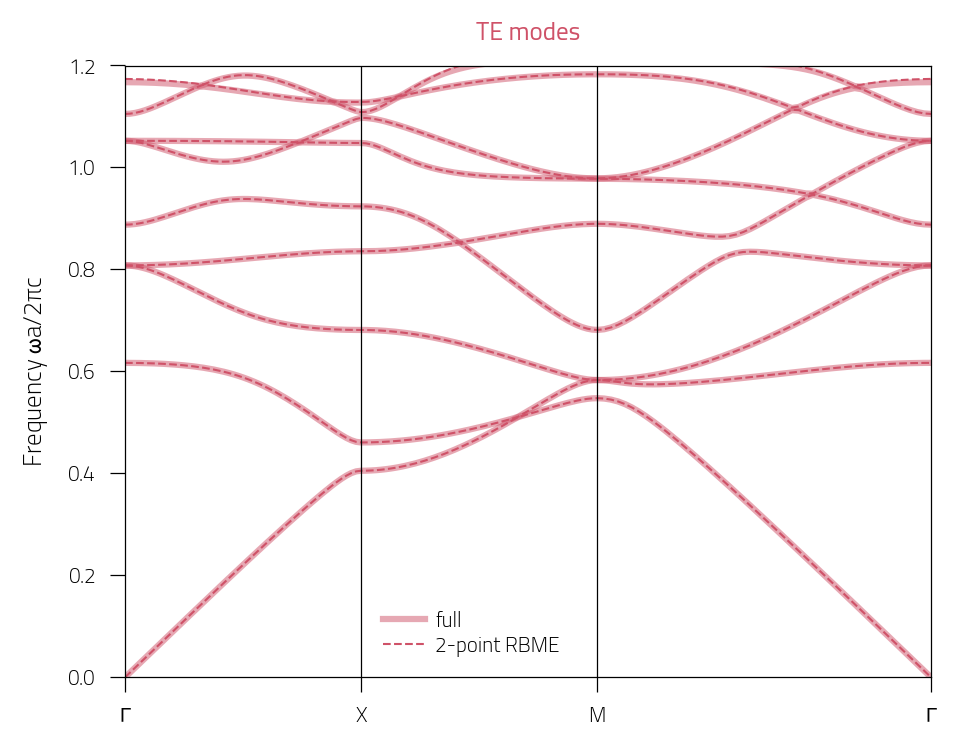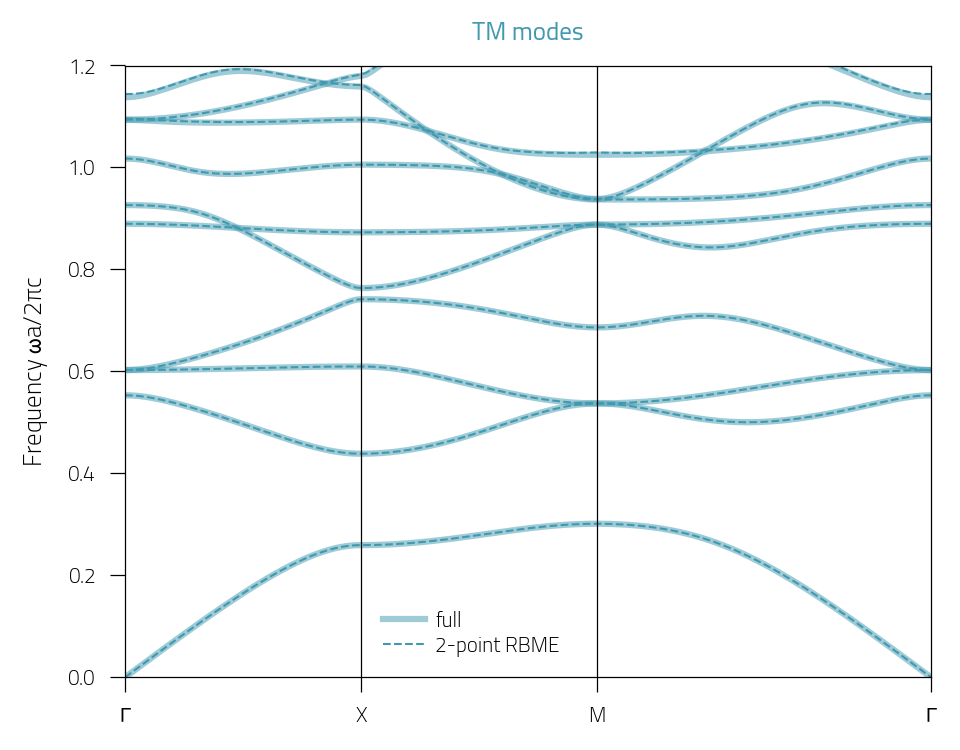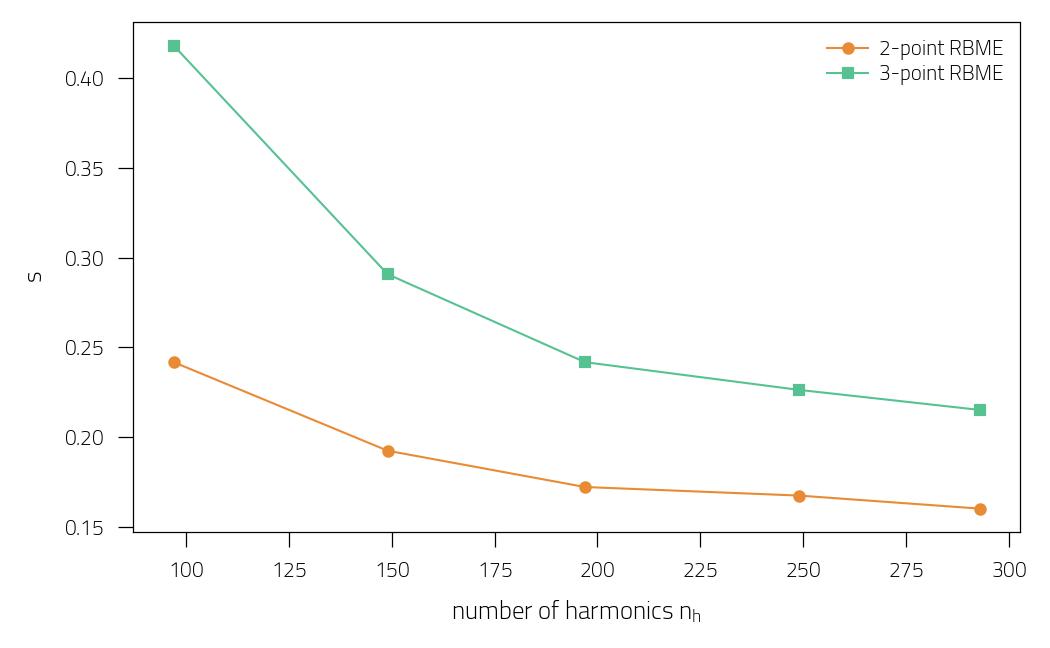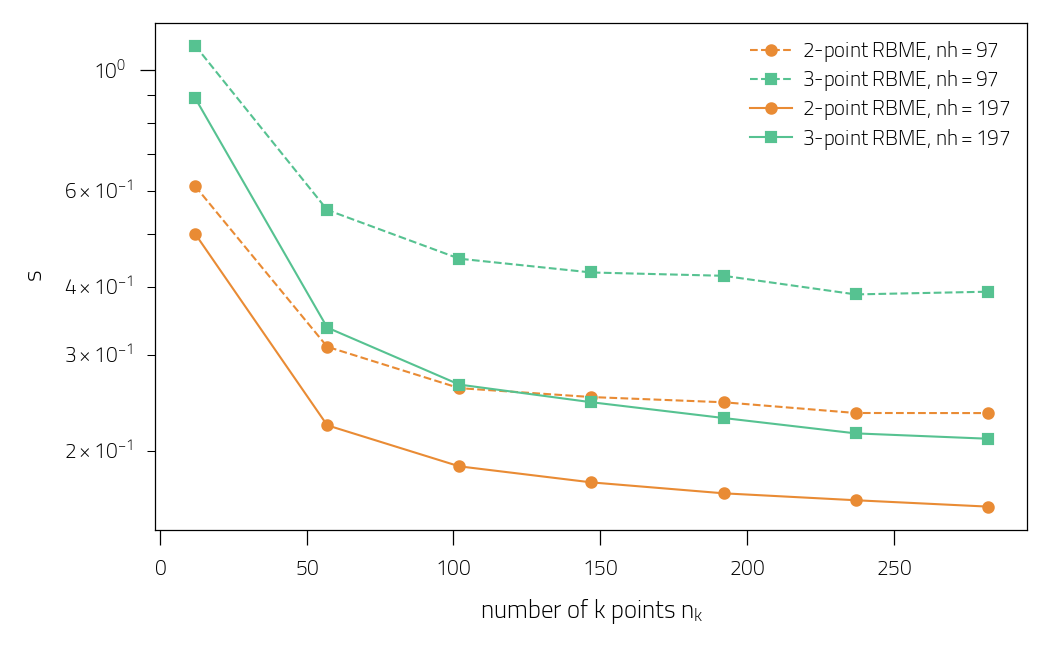Note
Go to the end to download the full example code. or to run this example in your browser via Binder
Reduced Bloch mode expansion#
Calculation of the band diagram of a two-dimensional photonic crystal.
import matplotlib.pyplot as plt
import numpy as np
import protis as pt
Reference results are taken from [Hussein2009].
Define the permittivity
We define here the wavevector path:
Full model:
def full_model(bands, nh=100):
t0 = pt.tic()
sim = pt.Simulation(lattice, epsilon=epsilon, mu=mu, nh=nh)
BD = {}
for polarization in ["TE", "TM"]:
ev_band = []
for kx, ky in bands:
sim.k = kx, ky
sim.solve(polarization, vectors=False)
ev_norma = sim.eigenvalues * a / (2 * np.pi)
ev_band.append(ev_norma)
# append first value since this is the same point
ev_band.append(ev_band[0])
BD[polarization] = ev_band
BD["TM"] = pt.backend.stack(BD["TM"]).real
BD["TE"] = pt.backend.stack(BD["TE"]).real
t_full = pt.toc(t0, verbose=False)
return BD, t_full, sim
Reduced Bloch mode expansion
def rbme_model(bands, nh=100, Nmodel=2, N_RBME=8):
t0 = pt.tic()
sim = pt.Simulation(lattice, epsilon=epsilon, mu=mu, nh=nh)
q = pt.pi / a
if Nmodel == 2:
bands_RBME = [(0, 0), (q, 0), (q, q)]
elif Nmodel == 3:
bands_RBME = [(0, 0), (q / 2, 0), (q, 0), (q, q / 2), (q, q), (q / 2, q / 2)]
else:
raise ValueError
rbme = {
polarization: sim.get_rbme_matrix(N_RBME, bands_RBME, polarization)
for polarization in ["TE", "TM"]
}
BD_RBME = {}
for polarization in ["TE", "TM"]:
ev_band = []
for kx, ky in bands:
sim.k = kx, ky
sim.solve(polarization, vectors=False, rbme=rbme[polarization])
ev_norma = sim.eigenvalues * a / (2 * np.pi)
ev_band.append(ev_norma)
# append first value since this is the same point
ev_band.append(ev_band[0])
BD_RBME[polarization] = ev_band
BD_RBME["TM"] = pt.backend.stack(BD_RBME["TM"]).real
BD_RBME["TE"] = pt.backend.stack(BD_RBME["TE"]).real
t_rbme = pt.toc(t0, verbose=False)
return BD_RBME, t_rbme, sim
bands, K = k_space_path(Nb=49)
BD, t_full, sim_full = full_model(bands, nh=100)
BD_RBME, t_rbme, sim_rbme = rbme_model(bands, nh=100, Nmodel=2, N_RBME=8)
print(f"speedup = {t_full/t_rbme}")
speedup = 4.423188411796422
Plot the bands:
def k_space_path_plot(Nb, K):
bands_plot = np.zeros(3 * Nb - 2)
bands_plot[:Nb] = K
bands_plot[Nb : 2 * Nb - 1] = K[-1] + K[1:]
bands_plot[2 * Nb - 1 : 3 * Nb - 2] = 2 * K[-1] + 2**0.5 * K[1:]
return bands_plot
bands_plot = k_space_path_plot(49, K)
TE polarization:
plt.figure(figsize=(3.2, 2.5))
plotTE = plt.plot(bands_plot, BD["TE"], c="#cf5268", lw=1.5, alpha=0.5)
plotTE_RBME = plt.plot(bands_plot, BD_RBME["TE"], "--", c="#cf5268")
plt.ylim(0, 1.2)
plt.xlim(0, bands_plot[-1])
plt.xticks(
[0, K[-1], 2 * K[-1], bands_plot[-1]], ["$\Gamma$", "$X$", "$M$", "$\Gamma$"]
)
plt.axvline(K[-1], c="k", lw=0.3)
plt.axvline(2 * K[-1], c="k", lw=0.3)
plt.ylabel(r"Frequency $\omega a/2\pi c$")
plt.legend([plotTE[0], plotTE_RBME[0]], ["full", "2-point RBME"], loc=(0.31, 0.02))
plt.title("TE modes", c="#cf5268")
plt.tight_layout()

/builds/protis/protis.gitlab.io/protis/examples/plot_rbme.py:141: SyntaxWarning: invalid escape sequence '\G'
[0, K[-1], 2 * K[-1], bands_plot[-1]], ["$\Gamma$", "$X$", "$M$", "$\Gamma$"]
/builds/protis/protis.gitlab.io/protis/examples/plot_rbme.py:141: SyntaxWarning: invalid escape sequence '\G'
[0, K[-1], 2 * K[-1], bands_plot[-1]], ["$\Gamma$", "$X$", "$M$", "$\Gamma$"]
TM polarization:
plt.figure(figsize=(3.2, 2.5))
plotTM = plt.plot(bands_plot, BD["TM"], c="#4199b0", lw=1.5, alpha=0.5)
plotTM_RBME = plt.plot(bands_plot, BD_RBME["TM"], "--", c="#4199b0")
plt.ylim(0, 1.2)
plt.xlim(0, bands_plot[-1])
plt.xticks(
[0, K[-1], 2 * K[-1], bands_plot[-1]], ["$\Gamma$", "$X$", "$M$", "$\Gamma$"]
)
plt.axvline(K[-1], c="k", lw=0.3)
plt.axvline(2 * K[-1], c="k", lw=0.3)
plt.ylabel(r"Frequency $\omega a/2\pi c$")
plt.legend([plotTM[0], plotTM_RBME[0]], ["full", "2-point RBME"], loc=(0.31, 0.02))
plt.title("TM modes", c="#4199b0")
plt.tight_layout()

/builds/protis/protis.gitlab.io/protis/examples/plot_rbme.py:159: SyntaxWarning: invalid escape sequence '\G'
[0, K[-1], 2 * K[-1], bands_plot[-1]], ["$\Gamma$", "$X$", "$M$", "$\Gamma$"]
/builds/protis/protis.gitlab.io/protis/examples/plot_rbme.py:159: SyntaxWarning: invalid escape sequence '\G'
[0, K[-1], 2 * K[-1], bands_plot[-1]], ["$\Gamma$", "$X$", "$M$", "$\Gamma$"]
Performances with number of harmonics
bands, K = k_space_path(49)
NH = np.arange(100, 350, 50)
actual_nh = []
s2 = []
s3 = []
for nh in NH:
BD, t_full, sim_full = full_model(bands, nh=nh)
BD_RBME2, t_rbme2, sim_rbme2 = rbme_model(bands, nh=nh, Nmodel=2, N_RBME=8)
BD_RBME3, t_rbme3, sim_rbme3 = rbme_model(bands, nh=nh, Nmodel=3, N_RBME=8)
actual_nh.append(sim_full.nh)
s2.append(t_full / t_rbme2)
s3.append(t_full / t_rbme3)
plt.figure()
plt.plot(actual_nh, s2, "o-", c="#e98b34", label="2-point RBME")
plt.plot(actual_nh, s3, "s-", c="#56c291", label="3-point RBME")
plt.xlabel(r"number of harmonics $n_h$")
plt.ylabel(r"speedup")
plt.legend()
plt.tight_layout()

Performances with number of k-space points
result = {}
NH = [100, 200]
num_ks = np.arange(5, 100, 15)
for nh in NH:
actual_nh = []
nk = []
s2 = []
s3 = []
for Nb in num_ks:
bands, K = k_space_path(Nb)
nk.append(len(bands))
BD, t_full, sim_full = full_model(bands, nh=nh)
BD_RBME2, t_rbme2, sim_rbme2 = rbme_model(bands, nh=nh, Nmodel=2, N_RBME=8)
BD_RBME3, t_rbme3, sim_rbme3 = rbme_model(bands, nh=nh, Nmodel=3, N_RBME=8)
actual_nh.append(sim_full.nh)
s2.append(t_full / t_rbme2)
s3.append(t_full / t_rbme3)
result[nh] = dict(s2=s2, s3=s3, actual_nh=actual_nh)
plt.figure()
plt.plot(
nk,
result[NH[0]]["s2"],
"o--",
c="#e98b34",
label=rf"2-point RBME, $nh={result[NH[0]]['actual_nh'][0]}$",
)
plt.plot(
nk,
result[NH[0]]["s3"],
"s--",
c="#56c291",
label=rf"3-point RBME, $nh={result[NH[0]]['actual_nh'][0]}$",
)
plt.plot(
nk,
result[NH[1]]["s2"],
"o-",
c="#e98b34",
label=rf"2-point RBME, $nh={result[NH[1]]['actual_nh'][0]}$",
)
plt.plot(
nk,
result[NH[1]]["s3"],
"s-",
c="#56c291",
label=rf"3-point RBME, $nh={result[NH[1]]['actual_nh'][0]}$",
)
plt.xlabel(r"number of k points $n_k$")
plt.ylabel(r"speedup")
plt.legend()
plt.tight_layout()

Total running time of the script: (3 minutes 35.009 seconds)
Estimated memory usage: 528 MB

